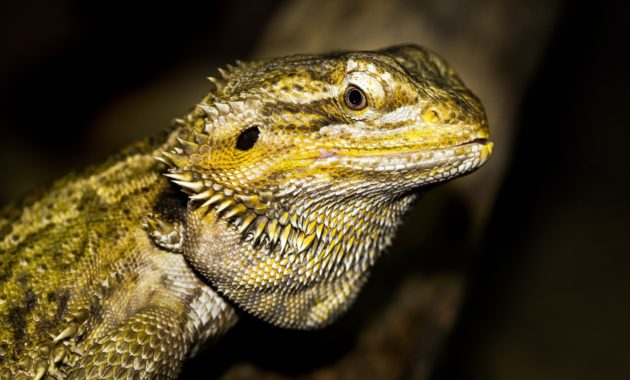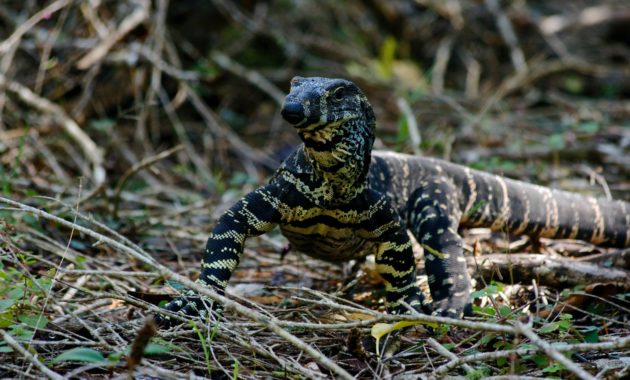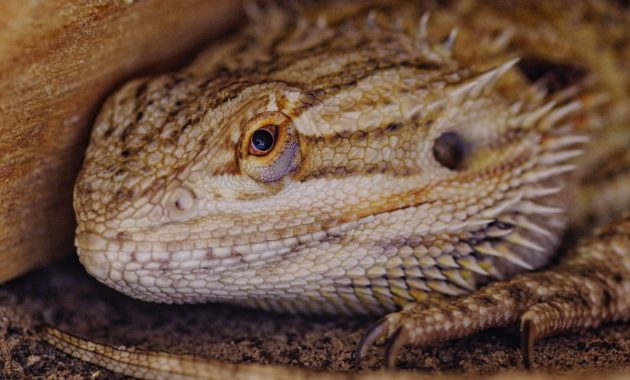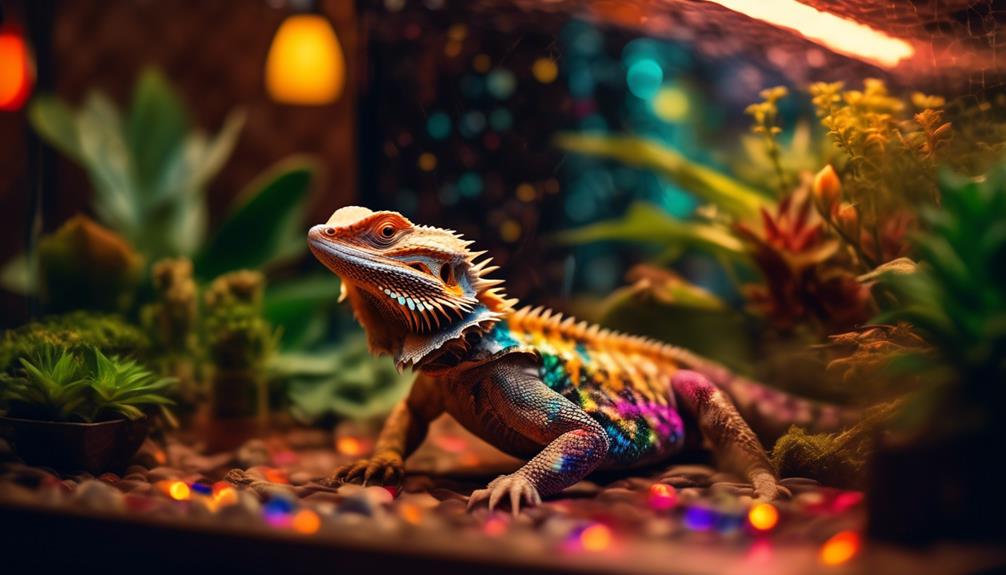
Welcome to the mesmerizing world of bearded dragons! These enchanting creatures, scientifically known as Pogona minor minor, have garnered attention for their impressive size and distinctive variations within the species.
From their chameleon-like ability to blend into their surroundings to their unique adaptations in various semiarid regions, there is so much to learn and explore about these magnificent reptiles.
Join us as we embark on a fascinating journey into the colorful world of bearded dragons, where every aspect of their existence is bound to captivate your imagination.
Key Takeaways
- Bearded dragons are large lizards, measuring up to 38cm in length.
- They have chameleon-like coloration, blending into their environments or displaying brighter colors during interactions.
- Bearded dragons can be found in various habitats such as woodland, heathland, desert, and coastal dunes.
- They exhibit unique behaviors such as waving their forelegs and engaging in head-bobbing, possibly related to social dominance.
Description and Appearance
Bearded dragons, scientifically known as Pogona minor minor lizards, are visually striking creatures with a distinct appearance. These large lizards measure about 38cm in length and have a chameleon-like coloration, allowing them to blend into their environments or display brighter colors during interactions. While they resemble Pogona nullarbor and Caimanops amphiboluroides, bearded dragons have smaller heads and different spine arrangements.
The western bearded dragon is widespread in Southwest Australia and central deserts, inhabiting semiarid regions such as woodlands, heathlands, arid deserts, and coastal dunes. Pogona minor minima, a smaller subspecies, can be found on West, North, and East Wallabi Islands, Houtman Abrolhos. Basking on fence posts is a common sight for these lizards.
Bearded dragons display unique behaviors, including waving their forelegs to elicit responses and engaging in head-bobbing to establish dominance. They lay egg clutches of 5-9, and due to their small size, they are likely insectivorous.
Color Variations
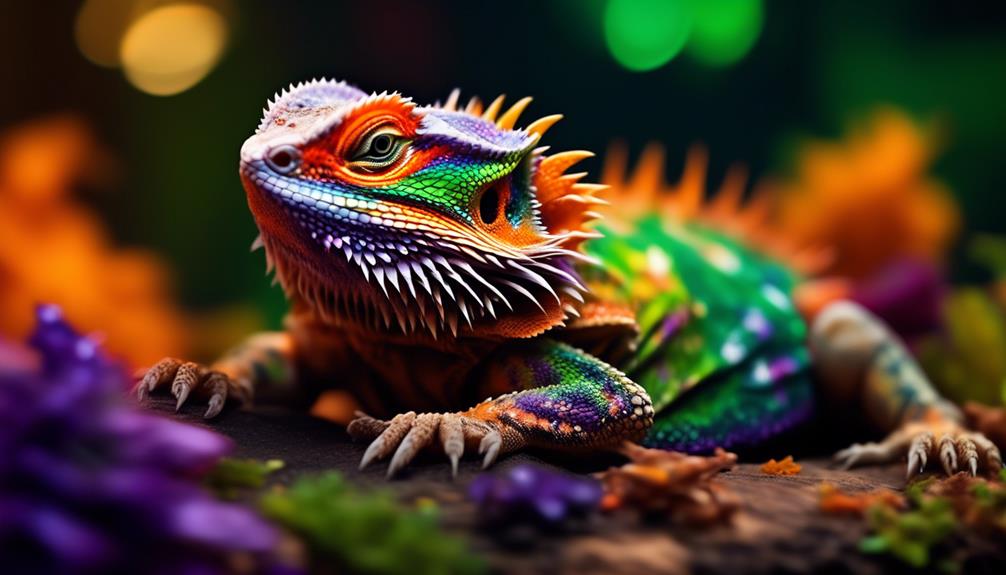
With their visually striking appearance, bearded dragons captivate onlookers not only with their unique physical attributes but also with their diverse array of color variations. These color variations can range from vibrant oranges and reds to more subdued shades of brown and grey.
One of the most well-known color variations is known as ‘normal’ or ‘wild type,’ which features a mixture of browns, tans, and grays, allowing the bearded dragon to blend into its natural environment. However, there are also several morphs or genetic variations that result in different color patterns.
These morphs include hypo, translucent, leatherback, and citrus, each with its own distinct coloration. Some bearded dragons may even display patterns or markings such as stripes or spots, further adding to their visual appeal.
Habitat and Range
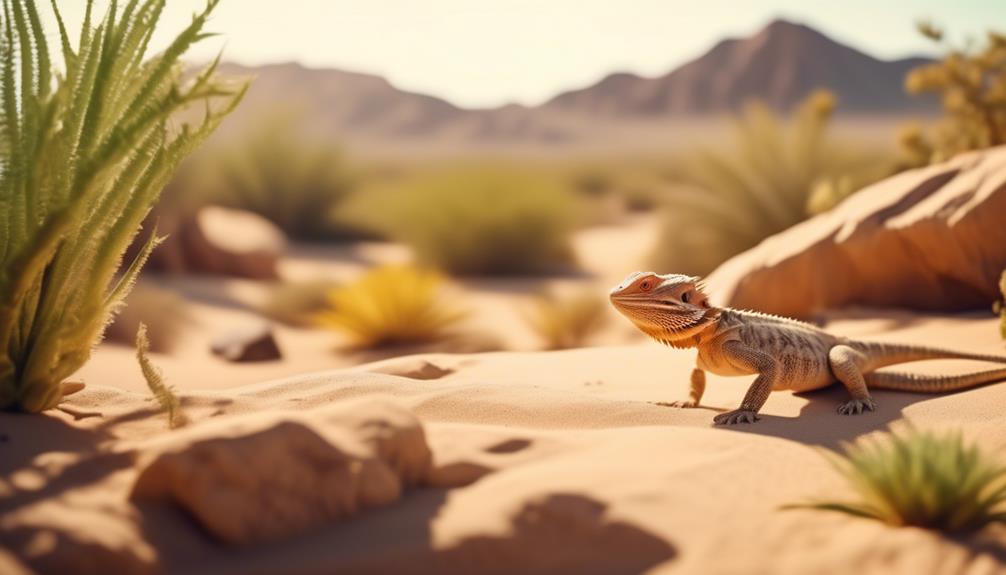
The western bearded dragon, known for its captivating color variations, can be found in a wide range of habitats throughout Southwest Australia and central deserts. These habitats include semiarid regions such as woodland, heathland, arid desert, and coastal dunes. They can also be spotted on Dirk Hartog Island.
Additionally, the Pogona minor minima subspecies can be found on West, North, and East Wallabi Islands, Houtman Abrolhos. It is not uncommon to see these fascinating creatures basking on fence posts.
The western bearded dragon’s adaptability to different habitats is a testament to their resilience and ability to thrive in diverse environments. This further adds to their appeal as captivating creatures in the world of reptiles.
Western Bearded Dragon
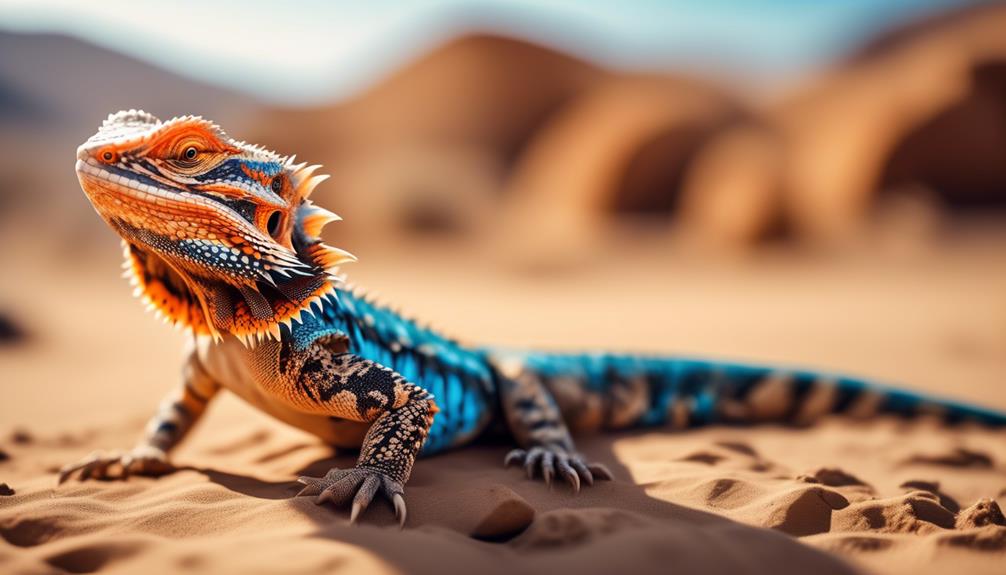
The western bearded dragon, a captivating and colorful lizard species native to Southwest Australia, showcases remarkable adaptability to diverse habitats. Here are three key features of the western bearded dragon:
- Size and Appearance: The western bearded dragon, scientifically known as Pogona minor minor, is a large lizard measuring around 38cm in length. Its smaller subspecies, Pogona minor minima and Pogona minor mitchelli, have snout to vent lengths of 11cm and 16cm, respectively. These lizards have a chameleon-like ability to change color, allowing them to blend into their environments or display brighter hues during interactions.
- Habitat and Range: The western bearded dragon is widespread in Southwest Australia and central deserts, occupying a range that includes semiarid regions like woodland, heathland, arid desert, and coastal dunes. They can also be found on Dirk Hartog Island. Pogona minor minima, a subspecies, is found on West, North, and East Wallabi Islands, Houtman Abrolhos. These adaptable lizards are often observed basking on fence posts.
- Behavior and Reproduction: Western bearded dragons display unique behaviors to communicate and reproduce. They wave one of their forelegs to elicit responses from potential rivals or mates. Males engage in head-bobbing, possibly to establish dominance within their social order. These lizards lay egg clutches of 5-9, with some recorded clutches of up to 15 eggs. Due to their smaller size, they are likely insectivorous rather than herbivorous like other bearded dragon species. The western bearded dragon shares many behaviors common to other Pogona species.
The western bearded dragon’s adaptability, distinctive appearance, and interesting behaviors make it a fascinating species to study and appreciate in the world of bearded dragons.
Pogona Minor Minima
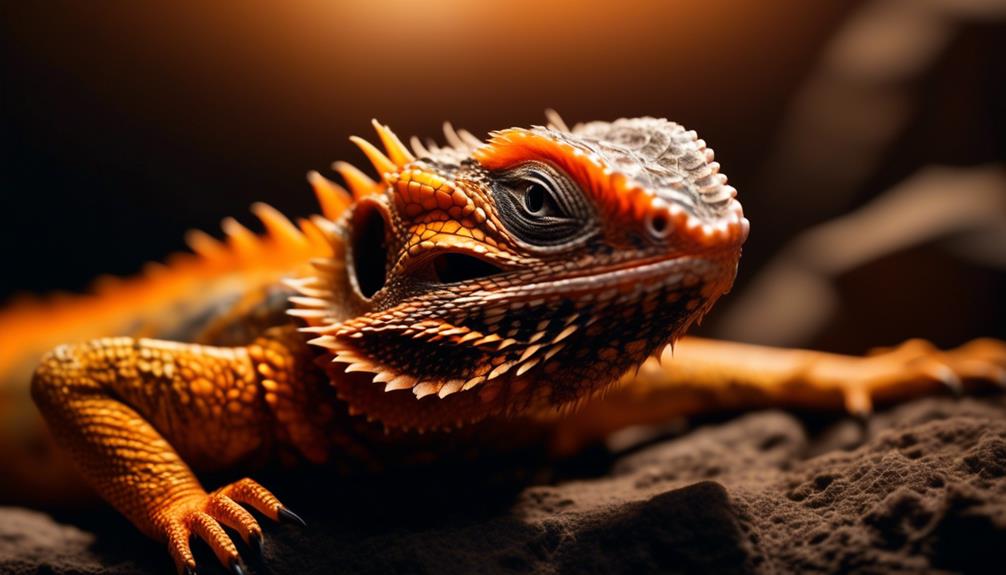
Pogona Minor Minima, a subspecies of the western bearded dragon, is characterized by its smaller size and distinct snout to vent length of 11cm. These lizards are found on West, North, and East Wallabi Islands, Houtman Abrolhos. They can often be spotted basking on fence posts. Here is a comparison between the different subspecies of bearded dragons:
| Subspecies | Size | Snout to Vent Length |
|---|---|---|
| Pogona minor minor | Large | 38cm |
| Pogona minor minima | Small | 11cm |
| Pogona minor mitchelli | Medium | 16cm |
Pogona minor minima, being smaller in size, likely has a different diet compared to other bearded dragon species. They may be more inclined towards an insectivorous diet rather than being herbivorous. These lizards exhibit behaviors common to other Pogona species, such as waving their forelegs and engaging in head-bobbing. Despite their smaller size, they lay egg clutches of 5-9, with some recorded clutches of up to 15. Pogona Minor Minima is an intriguing subspecies that adds diversity to the colorful world of bearded dragons.
Pogona Minor Mitchelli
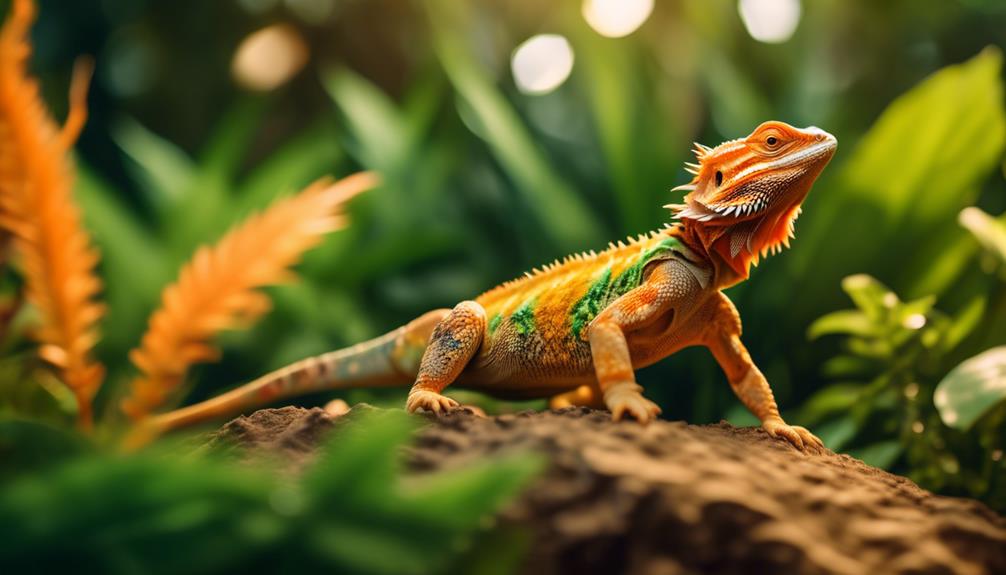
Continuing our exploration of the diverse world of bearded dragons, we now turn our attention to Pogona Minor Mitchelli, a subspecies distinguished by its unique characteristics and behaviors.
Here are three key features that set Pogona Minor Mitchelli apart:
- Vibrant Coloration: Pogona Minor Mitchelli showcases a striking array of colors, including shades of orange, red, and yellow. These vibrant hues not only serve as a form of camouflage but also play a role in communication among individuals.
- Arboreal Adaptations: Unlike other bearded dragon subspecies, Pogona Minor Mitchelli has adapted to an arboreal lifestyle. They possess longer limbs and strong claws, enabling them to climb trees and navigate their forested habitats with ease.
- Dietary Preferences: Pogona Minor Mitchelli has a specialized diet consisting primarily of insects and small vertebrates. Their smaller size allows them to hunt and consume prey that is proportionate to their body, ensuring they receive the necessary nutrients for growth and survival.
With its unique appearance, arboreal adaptations, and specialized diet, Pogona Minor Mitchelli offers a fascinating glimpse into the incredible diversity of the bearded dragon species.
Spine Arrangements
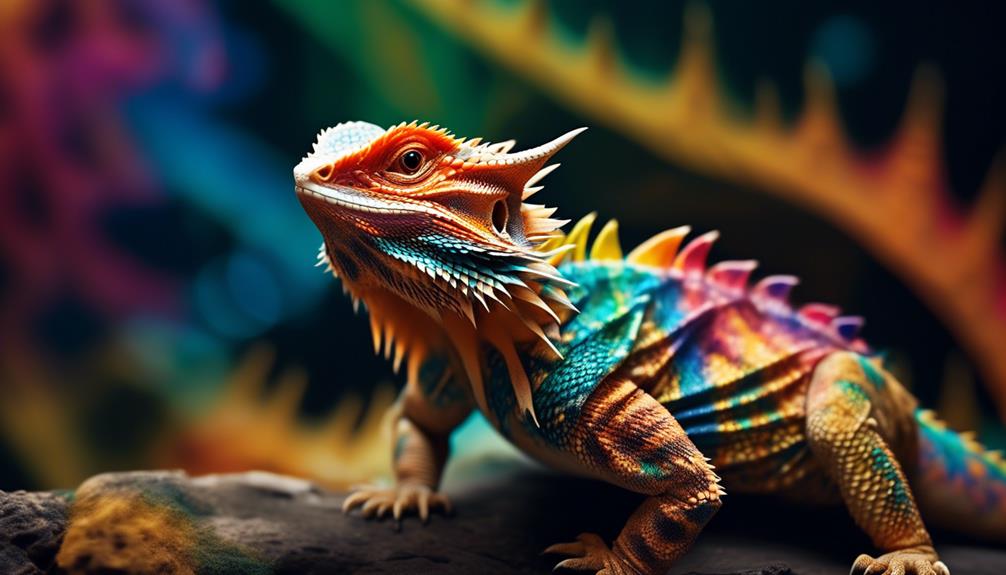
One notable characteristic of bearded dragons is their unique arrangement of spines. These spines, known as osteoderms, are small bony plates that form a row along the dragon’s back and sides. The arrangement of these spines varies among individuals and can even differ between different species of bearded dragons.
The spines are typically triangular in shape and are often raised or flattened depending on the dragon’s mood or behavior. During periods of aggression or defense, the spines may be raised to create a larger and more intimidating appearance. Conversely, when the dragon is relaxed or trying to conserve heat, the spines may be flattened against the body.
This distinct spine arrangement adds to the overall unique and fascinating appearance of bearded dragons.
Behavior and Communication
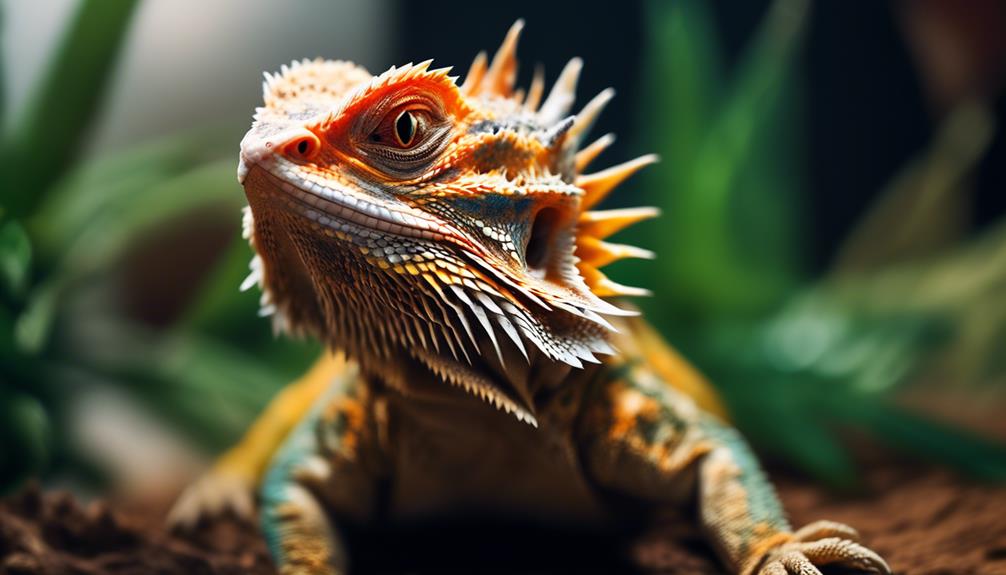
The fascinating behavior and communication of bearded dragons are integral to their unique and captivating nature, further complementing their distinct appearance with their intriguing interactions and social dynamics. Here are three noteworthy aspects of their behavior and communication:
- Arm Waving: Bearded dragons wave one of their forelegs to elicit responses from potential rivals or mates. This behavior serves as a visual signal to establish dominance or initiate courtship.
- Head-bobbing: Males engage in head-bobbing, a behavior possibly related to dominance within their social order. By rapidly bobbing their heads up and down, they communicate their status and assert their authority.
- Reproduction: Bearded dragons lay egg clutches of 5-9, with some recorded clutches of up to 15. This reproductive behavior highlights their ability to ensure the survival of their species through successful breeding and hatching of offspring.
These behaviors, along with their vibrant color displays, make bearded dragons a truly captivating and enchanting species to observe and study.
Head-bobbing and Dominance
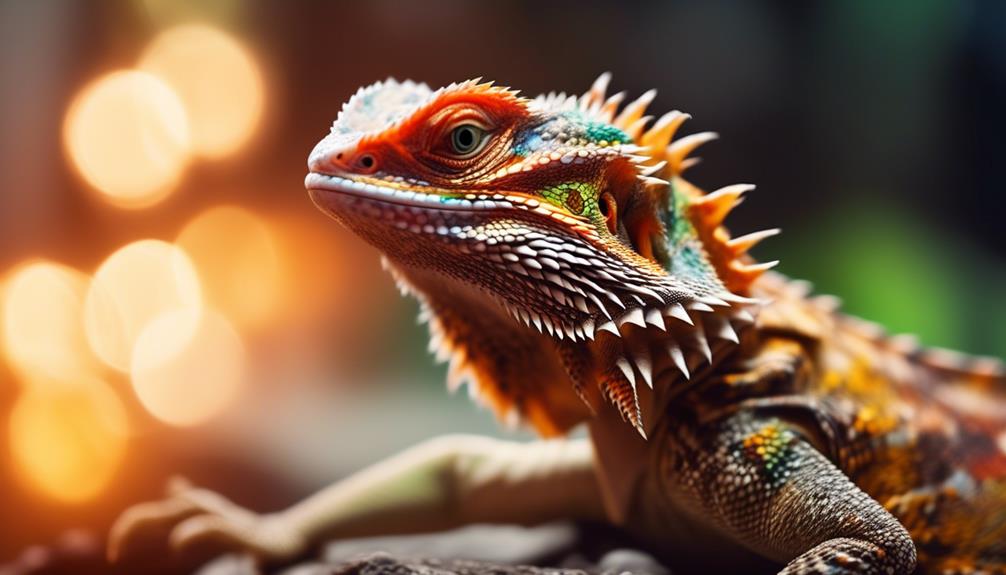
Head-bobbing is a distinctive behavior exhibited by male bearded dragons that serves as a visual communication tool, potentially linked to establishing dominance within their social hierarchy. This behavior involves rhythmic up-and-down movements of the head and is commonly observed during interactions between males or between males and females.
The head-bobs are often accompanied by a display of the bearded dragon’s vibrant coloration and extended throat pouch, further emphasizing their dominance. It is believed that head-bobbing allows bearded dragons to communicate their territorial boundaries, assert dominance, and attract potential mates.
The frequency and intensity of the head-bobbing behavior may vary depending on the individual’s age, size, and social status. Studying this behavior provides valuable insights into the social dynamics and communication strategies of these fascinating reptiles.
Reproduction and Clutches
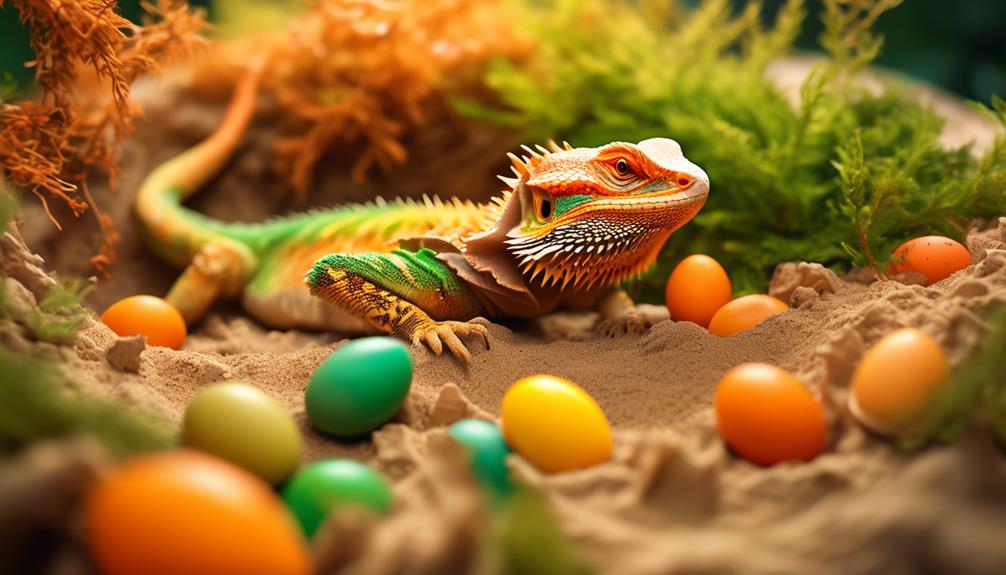
During the reproductive process, bearded dragons lay egg clutches containing 5-9 eggs, with some recorded clutches reaching up to 15 eggs.
Here are three interesting facts about the reproduction and clutches of bearded dragons:
- Incubation: After laying their eggs, female bearded dragons do not provide any further care. The eggs are left to incubate in the warm environment of their habitat. The incubation period typically lasts around 55-75 days, depending on the temperature.
- Sex Determination: The sex of bearded dragon hatchlings is determined by the incubation temperature. Lower temperatures during incubation tend to produce male hatchlings, while higher temperatures result in females. This unique temperature-dependent sex determination mechanism adds an interesting aspect to their reproductive process.
- Multiple Clutches: Bearded dragons are capable of producing multiple clutches in a single breeding season. After a successful mating, females can lay several clutches of eggs, typically spaced a few weeks apart. This helps ensure the survival and propagation of the species.
Diet and Feeding Habits

Bearded dragons have specific dietary requirements and exhibit unique feeding habits. These reptiles are omnivorous, meaning they eat a combination of plant matter and insects. Their diet primarily consists of leafy greens, vegetables, fruits, and a variety of insects such as crickets, mealworms, and dubia roaches. It is important to provide a well-balanced diet to ensure their nutritional needs are met. Bearded dragons also have interesting feeding habits, such as the ability to catch prey with their long, sticky tongues and their tendency to eat their food in small, bite-sized pieces. They are known to take advantage of natural sunlight to help with digestion and calcium absorption. Below is a table summarizing the diet and feeding habits of bearded dragons:
| Diet | Feeding Habits |
|---|---|
| Leafy greens | Catch prey with long, sticky tongues |
| Vegetables | Eat food in small, bite-sized pieces |
| Fruits | Take advantage of natural sunlight |
| Insects | Utilize natural sunlight for digestion and calcium absorption |
Comparison to Other Bearded Dragon Species
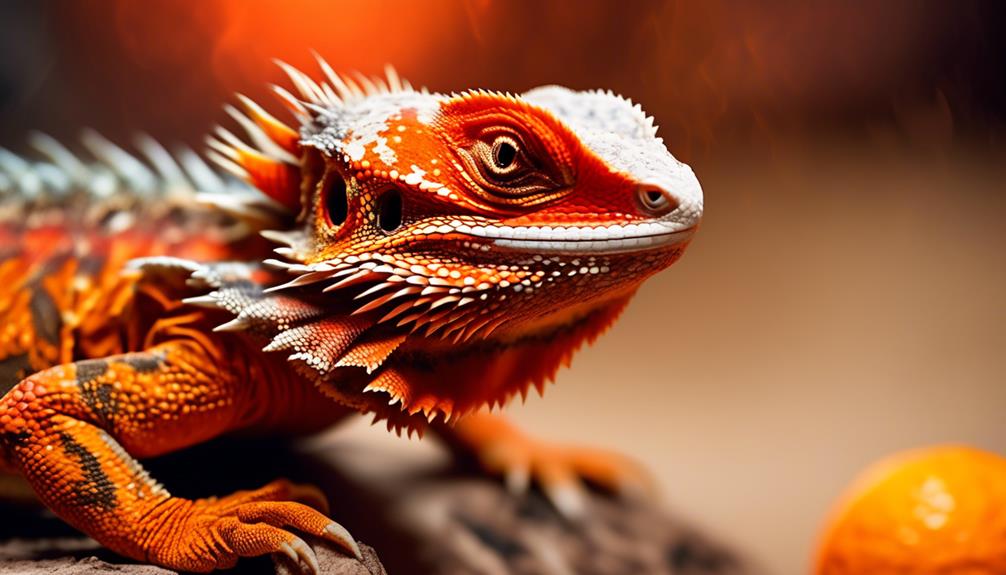
The bearded dragon species can be distinguished from other related species by their unique physical characteristics and distinct habitats. Here are three key points of comparison:
- Physical Characteristics: Bearded dragons, scientifically known as Pogona, are known for their chameleon-like coloration, allowing them to blend into their environments or display brighter colors during interactions. They have smaller heads and different spine arrangements compared to similar species like Pogona nullarbor and Caimanops amphiboluroides.
- Habitat: Bearded dragons have a wide distribution in Southwest Australia and central deserts, including semiarid regions like woodland, heathland, arid desert, and coastal dunes. They are often seen basking on fence posts. Pogona minor minima, a subspecies, can be found on West, North, and East Wallabi Islands in Houtman Abrolhos.
- Behavior: Bearded dragons engage in unique behaviors such as waving one of their forelegs to elicit responses from rivals or mates. Males also perform head-bobbing, possibly related to dominance within their social order. They lay egg clutches of 5-9, sometimes up to 15, and are likely insectivorous due to their small size.
Related Topics
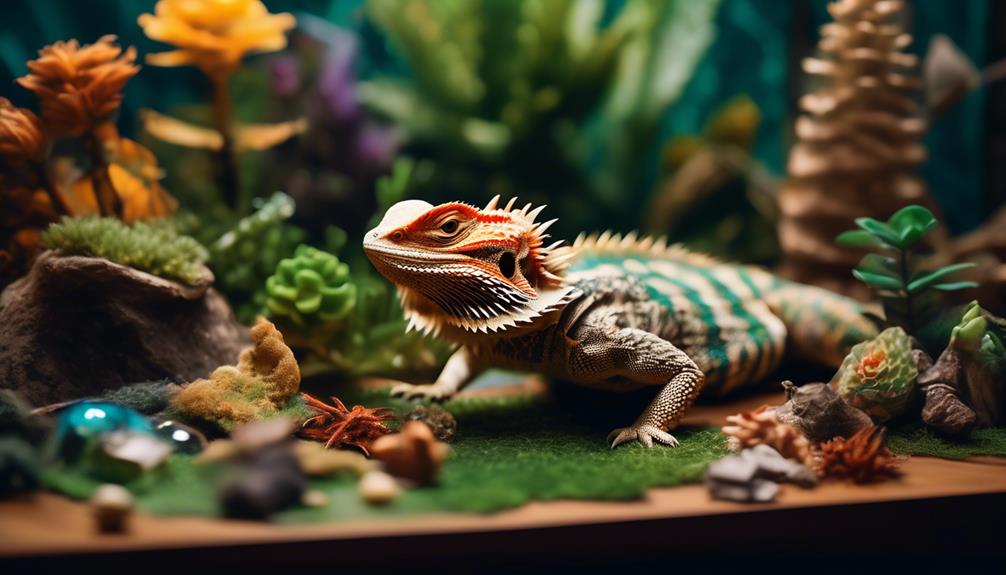
To further explore the world of bearded dragons, it is essential to delve into their related topics, shedding light on their conservation status, taxonomy, and literature dedicated to their study.
The conservation status of bearded dragons, specifically the western bearded dragon (Pogona minor), is of importance in understanding their population and habitat health.
Additionally, studying their taxonomy helps in understanding their evolutionary relationships and classification within the Agamidae family.
Literature dedicated to the study of bearded dragons, such as the book ‘Dragon Lizards of Australia’ and ‘Reptiles and Frogs in the Bush: Southwestern Australia,’ provides valuable insights into their behavior, habitat, and ecological interactions.
Conservation Status and IUCN Listing
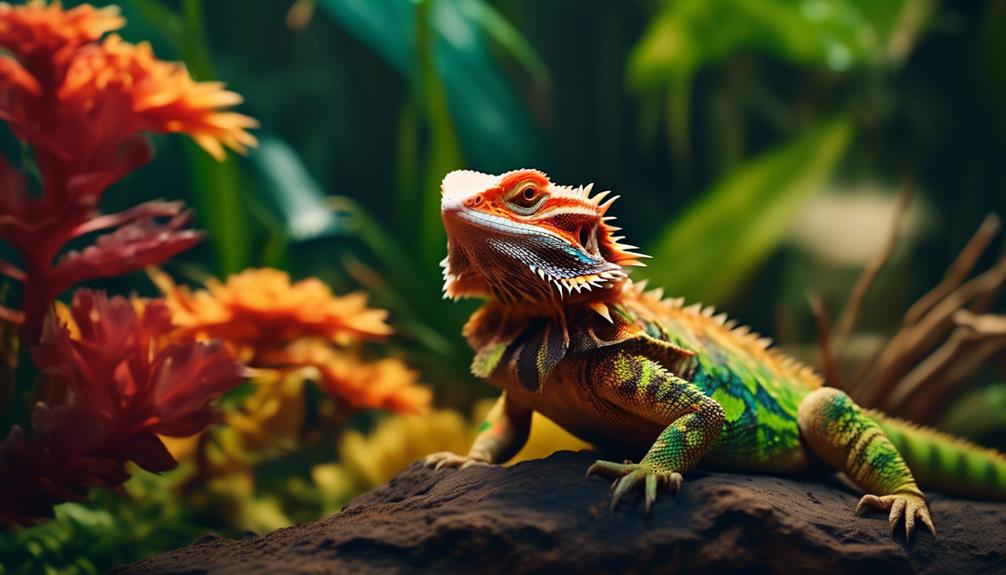
The western bearded dragon (Pogona minor) is of particular concern when considering its conservation status and listing on the IUCN Red List. Here are three key points to understand about its conservation status:
- Vulnerability: The western bearded dragon faces various threats to its population, including habitat loss, fragmentation, and degradation due to urbanization and agricultural activities. These factors contribute to the decline of suitable habitats for the species.
- Population Decline: The population of the western bearded dragon has been decreasing in recent years. This decline is primarily attributed to human activities, such as the clearing of land for development and the introduction of invasive species that compete for resources or prey on the lizards.
- Conservation Efforts: In response to these concerns, conservation initiatives have been implemented to protect the western bearded dragon. These efforts include habitat restoration, captive breeding programs, and public awareness campaigns to promote responsible land use practices and reduce threats to the species.
Additional Information
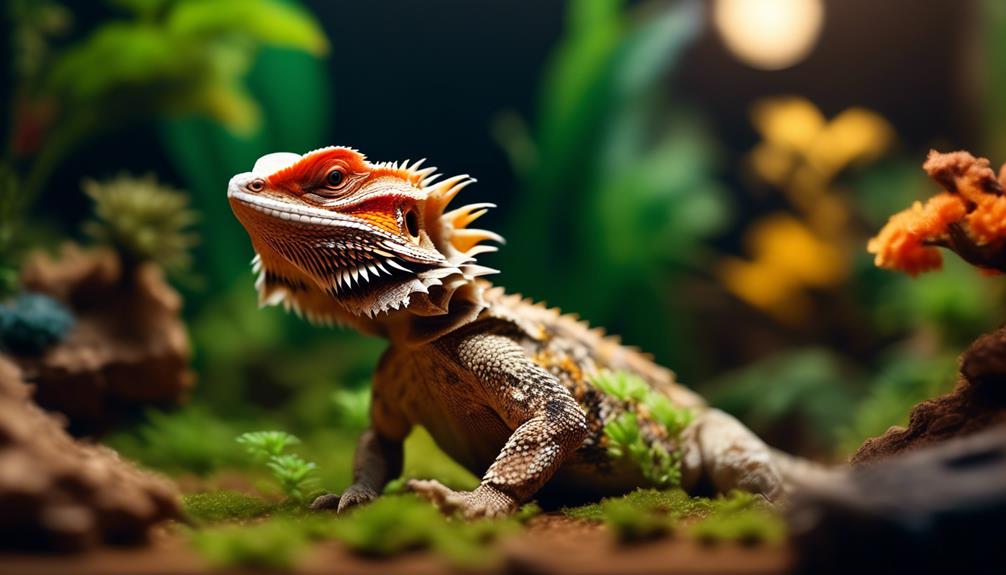
Furthermore, there are several notable facts and details that provide additional insight into the western bearded dragon’s characteristics and conservation status. This lizard, belonging to the Agamidae family, is listed as a species of least concern on the IUCN Red List. Taxonomically named by Richard Sternfeld in 1919, the western bearded dragon is widely distributed in Southwest Australia and central deserts, with its range encompassing various semiarid regions such as woodland, heathland, arid desert, and coastal dunes. It can also be found on Dirk Hartog Island, West, North, and East Wallabi Islands, Houtman Abrolhos. In terms of behavior, bearded dragons engage in unique displays such as waving their forelegs to elicit responses and head-bobbing for dominance. They lay clutches of 5-9 eggs, possibly due to their small size, which suggests insectivorous tendencies rather than herbivorous. The following table provides a summary of additional information about the western bearded dragon:
| Fact | Details |
|---|---|
| Conservation Status | Least Concern |
| Taxonomic Classification | Agamidae |
| Distribution | Southwest Australia and central deserts |
| Range of habitats | Woodland, heathland, arid desert, coastal dunes |
| Unique Behaviors | Foreleg waving, head-bobbing, egg-laying habits |
This additional information serves to deepen our understanding of the western bearded dragon’s characteristics, conservation status, and behavior.
Frequently Asked Questions
What Is the Average Lifespan of a Bearded Dragon?
The average lifespan of a bearded dragon is around 10 to 15 years. However, with proper care and diet, they can live up to 20 years or more.
Can Bearded Dragons Change Their Color?
Yes, bearded dragons can change their color. They have a chameleon-like ability to blend into their surroundings or display brighter colors during interactions. This is a fascinating adaptation that allows them to communicate and adapt to their environment.
Are Bearded Dragons Social Animals?
Bearded dragons are social animals, displaying behaviors such as waving forelegs to elicit responses and engaging in head-bobbing, possibly related to dominance. They lay egg clutches and exhibit behaviors common to other Pogona species.
How Many Eggs Does a Female Bearded Dragon Lay in One Clutch?
A female bearded dragon typically lays a clutch of 5-9 eggs, although some recorded clutches have contained up to 15 eggs. This species, belonging to the Agamidae family, is listed as least concern on the IUCN Red List.
Do Bearded Dragons Require Special Lighting in Their Habitat?
Bearded dragons require special lighting in their habitat. They need both UVA and UVB light to help with their calcium absorption and overall health. Proper lighting is essential for their well-being and should be provided in their enclosure.
What Colorful and Rare Animals Can Be Found in the World?
The rare Nullarbor dragon unveiled its vibrant, iridescent scales and distinctive markings in the Australian outback. This colorful and elusive creature is just one example of the many rare and captivating animals that can be found in different parts of the world.
Conclusion
In conclusion, the bearded dragon is a captivating creature known for its impressive size, unique color variations, and ability to adapt to various habitats.
With its chameleon-like ability to blend into its surroundings and display vibrant hues, the bearded dragon is truly a sight to behold.
From its smaller head and distinct spine arrangements to its intriguing communication methods and dietary preferences, this species offers a fascinating glimpse into the world of reptiles.
The bearded dragon’s conservation status and IUCN listing are also important factors to consider in preserving its natural habitat and ensuring its survival.

